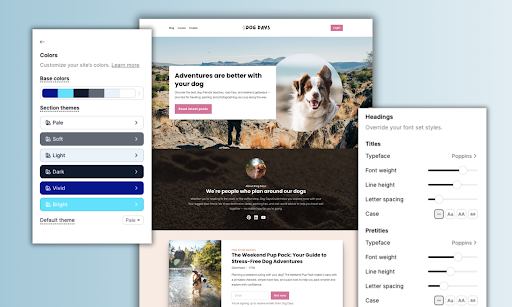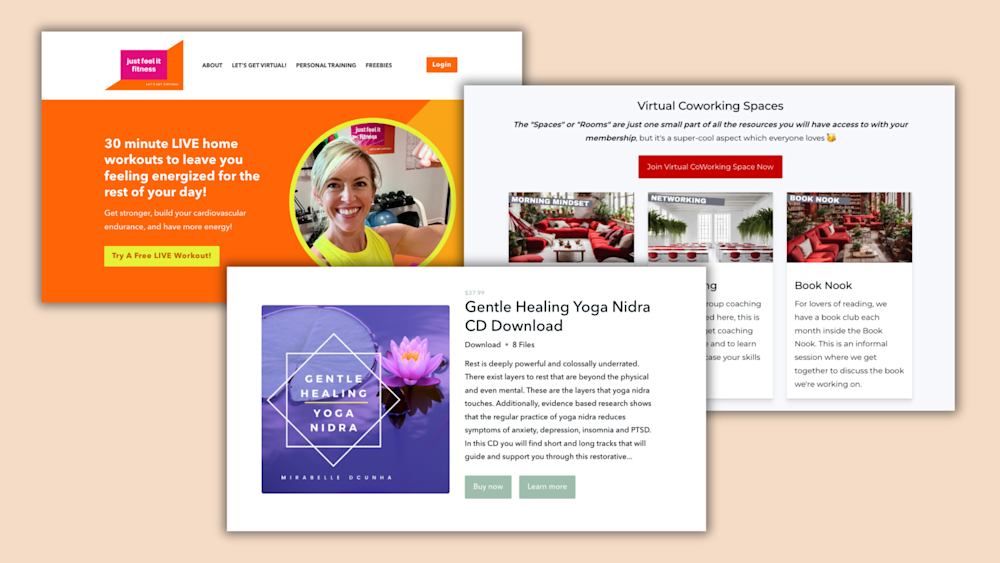You want to try something new and grow as a professional photographer.
Maybe you’re intrigued by the idea of starting an online business and becoming your own boss — or maybe you just want to earn some extra cash outside of your full-time job.
Either way, you’ve got valuable skills and experience to share as a photographer. No matter your niche, that means that there are plenty of unique side hustle opportunities out there just waiting to be explored.
Whether you’re looking to make some extra money with a side gig or want to make a move to self-employment, this guide is for you. We’ll share five different ways to turn your photography skills into income.
One note before we dive in: In this guide, we’ll be focusing on money-making alternatives to taking photos.
If you want to be your own boss and stay behind the camera, becoming a freelance photographer is an excellent option, too. This guide to making money as a freelancer and article on building a freelance portfolio on your own website are great places to start.
1. Submit your photos to stock photography sites
As a photographer, you know better than anyone that photography is a powerful visual medium.
Businesses, advertisers, and creators use photos to send a message, evoke emotion, and define their brand — but hiring a photographer is often out of their budget.
The solution? Stock photography. Stock images are photos, illustrations, and vector images that people can license for creative or commercial use.
Stock photography websites like Shutterstock, Getty Images, Bigstock, and iStock offer huge databases of photos that clients can look through when they need a photo for a marketing campaign, social media post, book cover, or pretty much anything else.
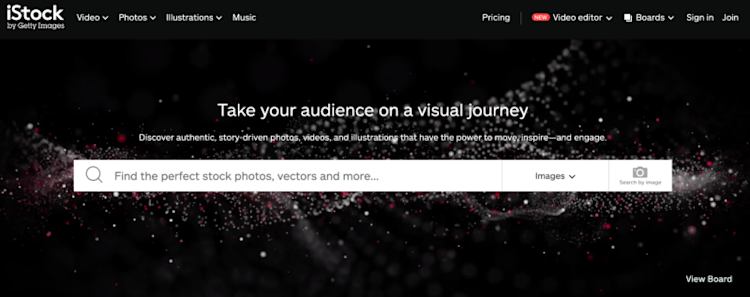
Most stock photo sites sell royalty-free images. An individual or business can license a royalty-free photo once, then use that image as many times as they want without paying royalties for each use or renewing the license.
Stock photos can range from landscape photography to ultra-niche subjects. There truly is a market for any kind of stock photo you can imagine. Each site has instructions for how to become a contributor, so you can find out how to sell photos on the stock photo site of your choice.
Your photos aren’t the only digital products you can sell online. This next side income opportunity moves away from fine art and into the written word.
2. Write an ebook
Selling information products like ebooks is a great way to bring in passive income.
Ebooks are one of the most popular info products on the market. The global ebook market is expected to grow by $6.93 billion from 2021–2025.
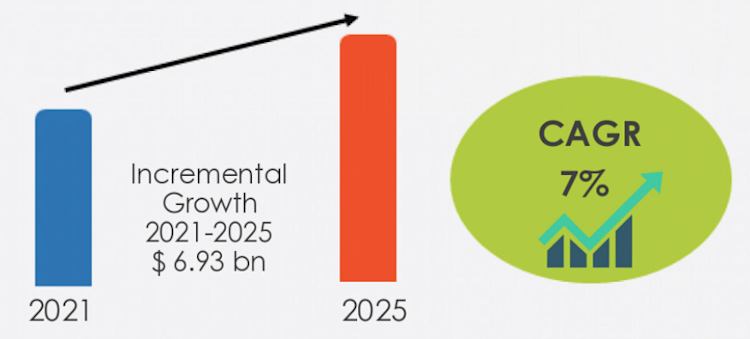
You don’t have to sell ebooks on Amazon or work with a publisher to be a part of that growth. In fact, you can make more money by selling ebooks on your own website.
There are a lot of advantages to selling digital downloads on your own site, including:
-
You have more control over your branding.
-
You don’t have to pay Amazon listing and transaction fees.
-
You get paid more quickly.
-
You have direct contact with your customers, so you can build relationships and keep them in the loop when you release new products.
The ebook creation process might seem time-consuming, especially if you’re looking for a quick side hustle, but writing your first ebook doesn’t have to be a lengthy endeavor. You can write an ebook in one week, then sell it to make passive income for months (or even years) to come.
If you’re running extra-short on time, consider repurposing your blog content into an ebook. Take your most popular photography blog posts and expand on them. Then, once you finish writing, use a platform like Reedsy to easily format your ebook.
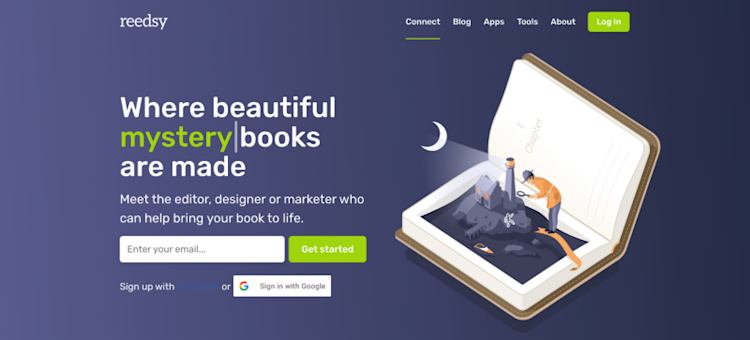
No matter how you go about writing your ebook, choose a topic that matches both your area of expertise and your audience’s goals. What’s your niche? What type of photography are you the “go-to” person for when people have questions?
Take Mallika Malhotra of MikiFoto + Co, for example. Mallika is a photographer and branding expert who helps female entrepreneurs “master their message, become the face of their biz, and build their brand empires”.
Mallika used her mission and expertise to write The Brand Photography Playbook, an ebook that helps entrepreneurs plan and prepare for their brand photoshoot.
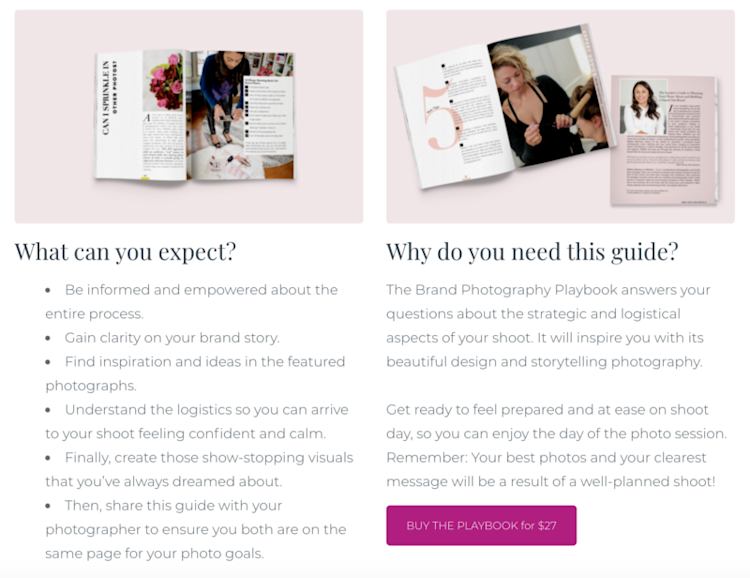
Food photographer Darina Kopcok of Gastrostoria also turned her niche-specific experience into an ebook, Rule-of-Thirds: A Guide to Composition for Food Photography.
The photo book includes a behind-the-scenes look at Darina’s process, case studies from her portfolio, 42 compositional diagrams, and more.

As a commercial food photographer and photography educator, Darina clearly understands her audience’s pain points and has created a resource that both showcases her art and helps fellow photographers reach their goals.
Podia’s all-in-one platform makes it easy for creators like Mallika and Darina to sell ebooks, online courses, and other digital products — all from a single dashboard, at one single price. Start your 30-day free trial.
Speaking of other digital products, our next side income tip focuses on selling another type of digital download: editing presets and templates.
3. Sell editing presets and templates
Successful photographers are skilled at more than just taking photos — they need to be good at editing and retouching, too. After you step out from behind the camera, knowing how to edit images can turn an ordinary photo into an extraordinary one.
Photo editing can be complex and time-consuming, especially if you’re taking a ton of photos. That’s why editing presets are such a popular digital download for photographers to sell.
If you’re an editing pro, selling Adobe Photoshop Lightroom presets can be an excellent way to bring in passive income.
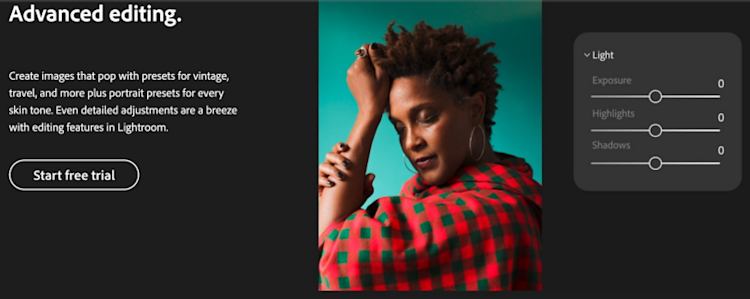
Editing presets are premade editing settings. In Lightroom, you move sliders to change the saturation, brightness, and contrast of a photo. Once you find a combination of settings you like, you can save that combination as a preset.
When you apply that preset to a photo, it automatically adjusts all of the settings with the click of a button.
Signature Edits sells 14 different Lightroom preset collections on their Podia site, ranging from “Clean & Classic” to a Christmas-themed preset collection. They also offer a product bundle of their entire library of Lightroom presets at a steep discount.
With over 80K customers to date, glowing customer testimonials make it clear that the Signature Edits team offers a helpful tool and a stellar customer experience.
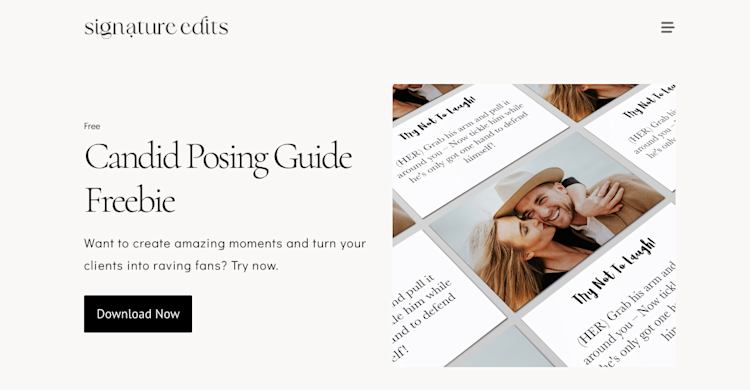
If presets aren’t your cup of tea, there are plenty of other digital downloads you can sell. Think about your own photography — do you use a template or checklist to make parts of your process go more smoothly? Consider selling those resources as downloads for other photographers.
For example, wedding photographer Taylor Jackson knows firsthand what goes into shooting a wedding. She sells a printable wedding photography checklist to help other photographers get all of the right shots on the big day.
All in all, selling digital downloads is a set-it-and-forget-it way to bring in passive income. Our next side income idea takes a more hands-on approach.
4. Coach, mentor, and connect with other photographers
If you have years of experience under your belt, you can sell coaching services to other photographers in the same niche facing the same challenges you’ve overcome.
As you market your coaching services, tell potential clients what makes your perspective and experience unique.
For instance, Darina Kopcok from our earlier example is an experienced commercial food photographer and photography educator, making her uniquely qualified to offer food photography mentorship programs.
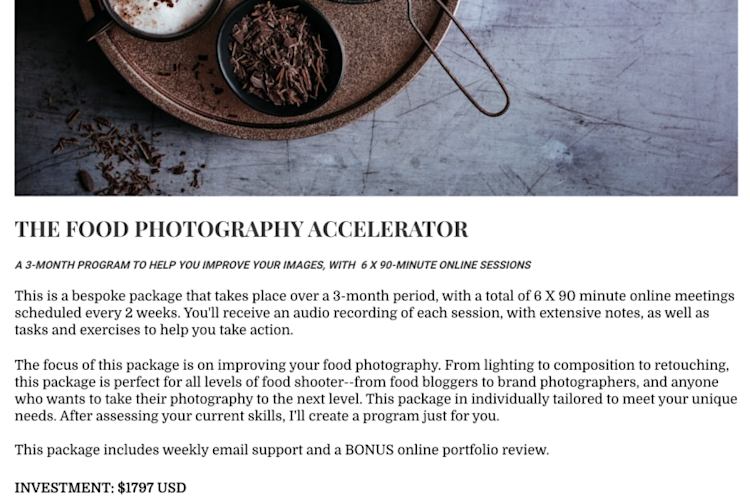
Darina offers coaching on marketing, photography skills, and building a full-time food photography business — all areas she has excelled in.
Digital marketing strategist, content creator, and photographer Adrian Lard is another top-notch coaching example. Adrian offers private one-on-one coaching calls for photographers looking to grow their businesses:
“Together, we will lay everything on the table. We will take an in-depth look at where your business is currently and where you long to be. Then, we will create a practical action plan to achieve your goals.”
Adrian uses his expertise as a marketer and photographer to help others achieve their photography business goals. Each call is a 60-minute strategy session, making it a significant time investment on Adrian’s part.
But if you're looking for the most scalable way to earn more money as a photographer, check out this fifth option.
5. Teach online photography courses
Like ebooks and coaching, the market for online courses is growing fast, and it shows no signs of slowing down.
From in-person classes moving online to experts making their knowledge more accessible, there’s never been a better time to take or create an online course.
Selling online courses and tutorials is another (mostly) passive income opportunity for photographers looking to share their knowledge. You build your online course once, then all that’s left to do is market your course to potential students.
To plan out your course content, start with the end result you want students to achieve, then create a step-by-step plan to reach that result. Each of those steps can be a lesson or module in your online course.
For example, Addie Gray of Addie Abroad created The Wanderlust Photo Lab online course with a specific outcome in mind: helping amateur photographers feel more comfortable using their DSLR cameras to capture beautiful travel photography.
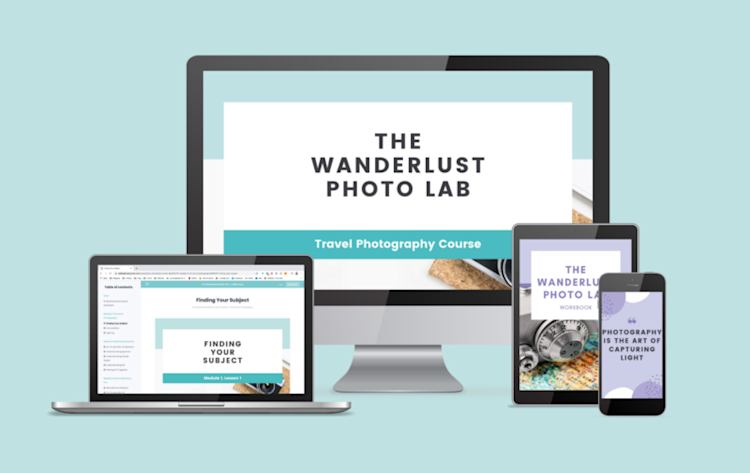
All of the lessons and resources in Addie’s course help her students reach that end goal, from a module on the basics of exposure to a 33-page workbook.
If you’re an expert in a particular photography niche, focus your course on that, like Cole Connor’s Real Estate Photography 101 course.
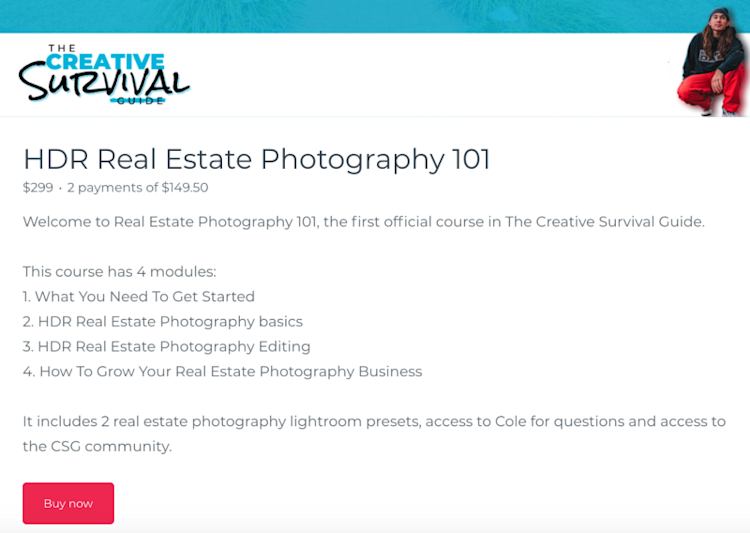
You also don’t have to target professionals with your course. There are tons of amateur photographers out there who would love to take their hobby to the next level with an online course.
Last but not least, don’t forget about editing skills. If you’re a talented photo editor, you can share that knowledge with fellow photographers, too. For example, Pretty Presets & Actions offers two editing courses on their Podia site, one for Lightroom and one for Photoshop.
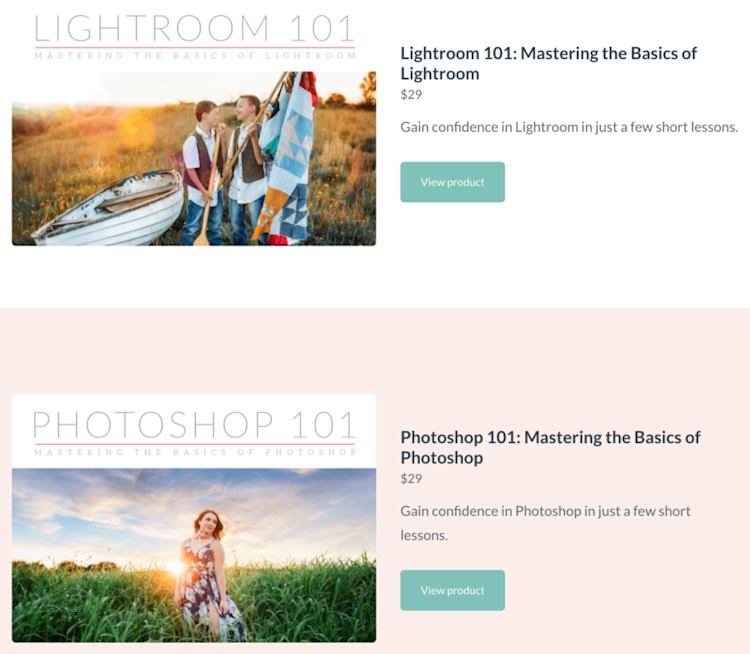
Want to start selling online courses like Cole Connor and Pretty Presets? Sign up for a 30-day free trial of Podia. You can build unlimited courses, webinars, digital products, and coaching sessions on all plans, and Podia also includes your website, blog, landing pages, and email marketing.
Now, get out there and start sharing your knowledge with the world. We can’t wait to see what you create.

